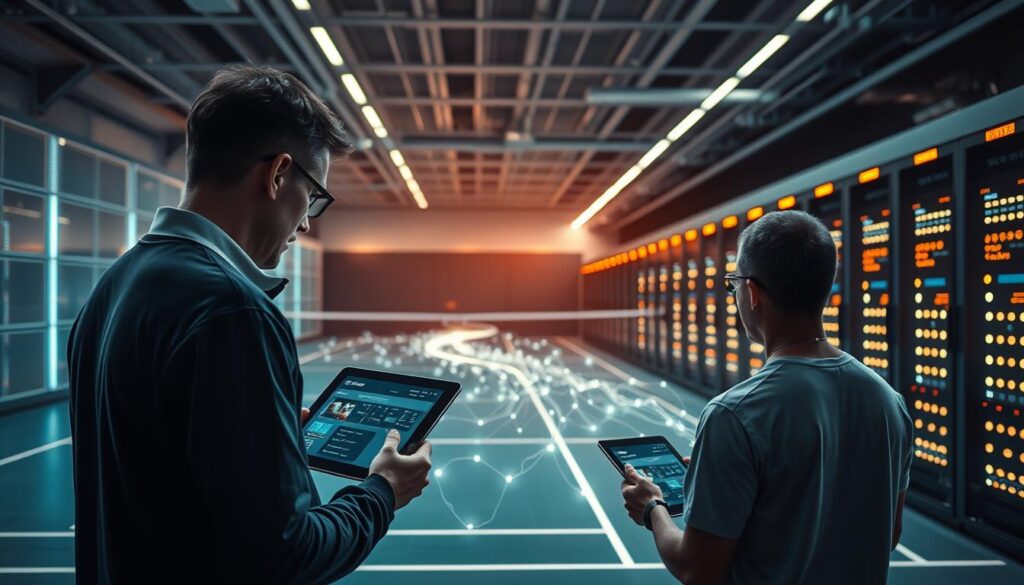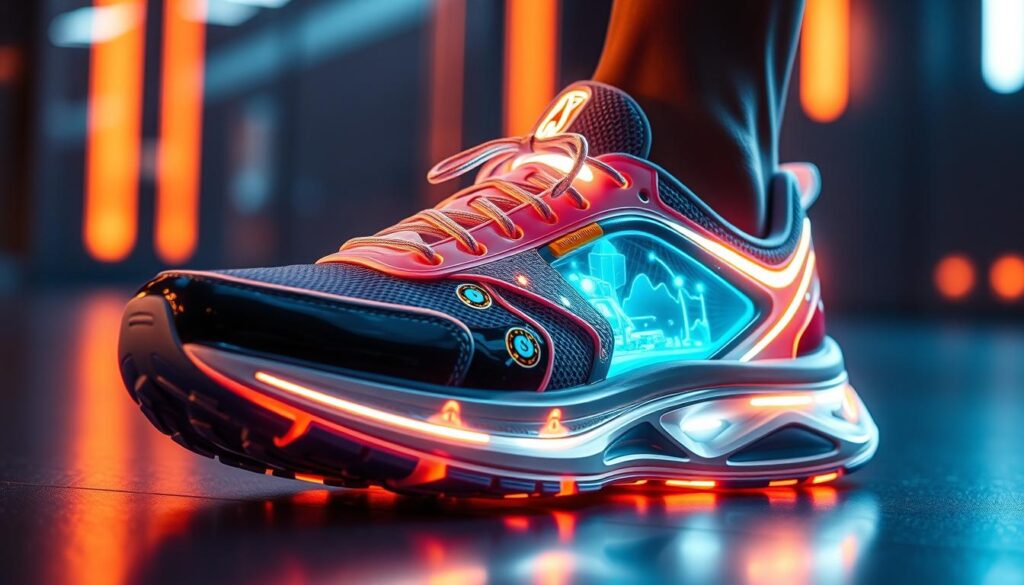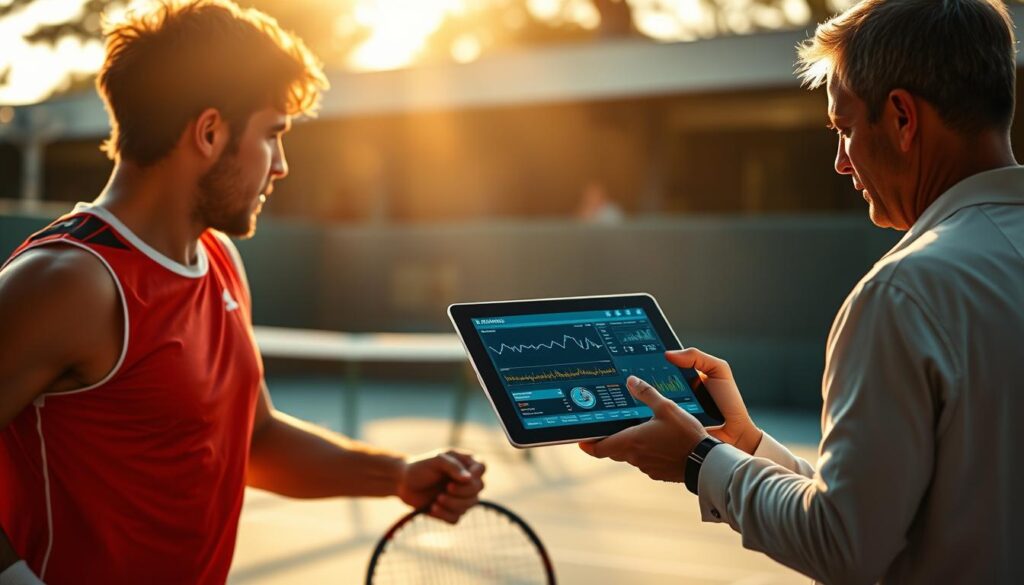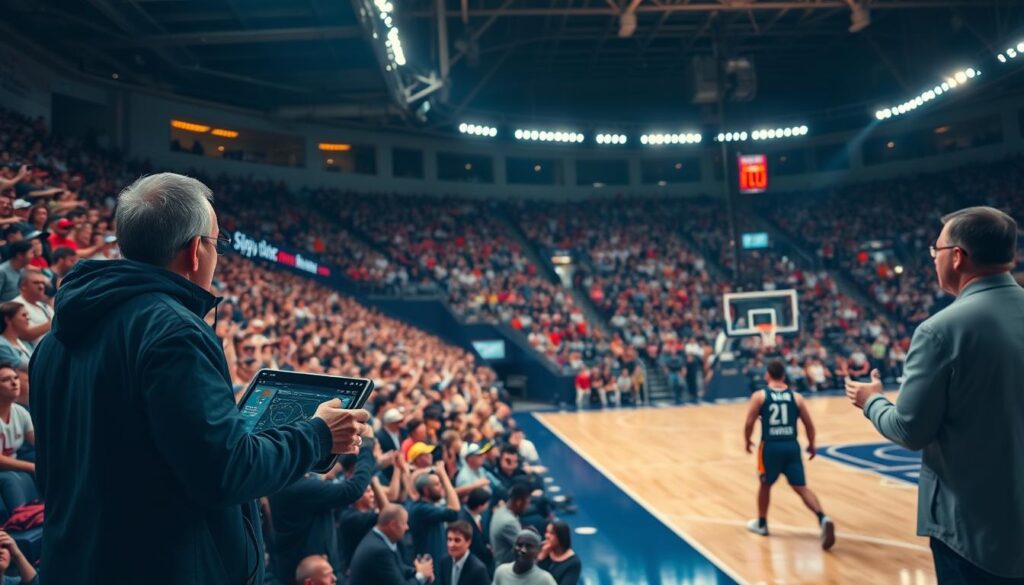One afternoon, a coach paused mid-drill. An athlete seemed off—slower reactions, shallow breath. The coach sent the player to the sidelines and checked a live dashboard.
That quick check changed the practice. Connected sensors had flagged rising temperature and a dip in cadence. Cloud and edge systems combined to turn those signals into clear, timely insights.
![]()
This guide shows how wearable sensors, BLE and Bluetooth gateways, 5G and LPWANs, plus cloud-edge computing form a seamless pipeline. Iottive’s end-to-end capabilities in BLE app development, firmware, and cloud integration help teams move from concept to reliable solutions.
Expect clear examples—from instrumented apparel to smart eyewear—plus practical templates for KPIs, governance, and integration with coaching workflows. The result: faster decisions, safer athletes, and better game performance across the industry.
Key Takeaways
- Connected devices translate on-field actions into usable data and insights.
- Cloud-edge systems reduce latency where milliseconds matter.
- Interoperability prevents costly data silos and keeps systems future-ready.
- Iottive offers BLE, mobile, and cloud expertise to deliver end-to-end solutions.
- Deployments unlock faster decisions, safer athletes, and enhanced fan experiences.
Why IoT Sports Analytics Matter Right Now
Decision-makers in U.S. sports seek systems that convert large data flows into clear coaching actions. Teams and leagues want practical, market-ready approaches that tie device signals to health, training, and game outcomes.
User intent in the United States market
In the U.S., organizations look for fast validation and measurable ROI. Executives view projections for analytics and AI adoption as a signal: pilots must move to scale. Investment drivers include monitoring, forecasting, and mobile apps that assess skill and workload.
From stats to strategy: turning vast amounts data into decisions
Sensors and apps broaden access to usable insights for coaches and athletes. Unified systems beat siloed stats by delivering curated dashboards, alerts, and role-based access that guide training and in-game choices.
- KPIs matter: availability, latency, and accuracy ensure data improves performance.
- Map use cases to ROI: reduce injury risk and grow revenue via engagement and sponsorship.
- Start small, validate fast, then scale with coach involvement to secure adoption.
Iottive understands U.S. team and league needs and can help align programs with compliance and mobile expectations. Contact: www.iottive.com | sales@iottive.com.
Core Technologies Behind Connected Sports Performance
A layered tech stack — from on-body sensors to cloud services — makes precise performance monitoring possible in busy venues.
Sensors and wearables capture heart rate, temperature, hydration, and motion. IMUs record biomechanics. Optical and electrical sensors read pulse and hydration markers. Temperature sensors enforce safety thresholds during intense training.

Connectivity stack
Bluetooth Low Energy suits low-power wearables. 5G handles high-throughput uplinks with low latency. LPWANs cover wide venue ranges when many devices are present.
Cloud and edge computing
Process urgent alerts at the edge to cut delay. Use cloud storage for historical analytics and coach dashboards. Balance both to protect battery life and scale systems.
Interoperability and resilience
Standard schemas and APIs prevent vendor lock-in. Secure device identity, OTA updates, and telemetry pipelines keep systems reliable as sensors multiply.
“Modular architectures let teams add new sensors without rebuilding core integrations.”
| Layer | Function | Example |
|---|---|---|
| Wearable | Capture heart rate, motion, temp | BLE earbuds, chest straps, IMU patches |
| Connectivity | Transport and range | BLE, Wi‑Fi, 5G, LPWAN |
| Processing | Edge alerts; cloud analytics | Edge nodes; cloud time-series DBs |
Iottive builds BLE firmware, mobile apps, and cloud integration to keep data flowing. Contact: www.iottive.com | sales@iottive.com.
IoT Data Pipeline: From Field Devices to Actionable Insights
A reliable pipeline turns raw sensor signals on the field into clear, actionable dashboards for coaches. A good design balances latency, cost, and privacy while moving data from devices to visualization.

Gateway choices and WAN considerations
Choose gateways based on range and power needs. BLE fits short-range, low-power wearables. Zigbee supports resilient mesh networks. LoRaWAN covers long-range, low-throughput stadium zones.
Cloud platforms and storage patterns
Use managed platforms—AWS IoT Core, Azure IoT Hub, or GCP Cloud IoT Core—for secure onboarding and certificate management.
Storage tiers: hot (S3/Blob/GCS) for recent streams, warm for aggregated sets, cold for archival. DynamoDB or other NoSQL stores hold metadata and fast lookups.
Streaming, processing, and machine learning
Ingest with Kinesis or Pub/Sub, transform with Glue or equivalent, and feed ML services like Azure ML or GCP AutoML for anomaly detection and injury prediction.
Edge preprocessing and batching cut latency. Schema validation and calibration logs keep the datasets trustworthy.
Dashboards and coach-facing design
Design for roles: coaches, medical staff, and athletes need views with thresholds, alerts, and drill-downs. Power BI, Tableau, and Google Data Studio map well to these workflows.
- Compare gateways: BLE, Zigbee, LoRaWAN for range and power trade-offs.
- Secure message routing via AWS IoT Core / Azure IoT Hub / GCP Core.
- Hot/warm/cold storage with S3/Blob/GCS and DynamoDB for metadata.
- Streaming with Kinesis + Glue to deliver clean, coach-ready datasets.
- Privacy-by-design: minimal collection, encryption, and granular access control.
“Iottive builds end-to-end pipelines—from BLE gateway integration to AWS/Azure/GCP ingestion and mobile visualization—so teams can act on insights fast.”
Contact: www.iottive.com | sales@iottive.com
IoT sports analytics, real-time player tracking, AI sports strategy tools
Combining wearable telemetry with vision feeds turns raw signals into coach-ready insights. Iottive links GPS/IMU devices and edge video to cloud ML so staff get positional and workload views during sessions and games.
Live stacks to optimize training and tactics
Define stacks that pair GPS, IMU wearables, and on-field video for instant positional maps and load metrics. Edge inference trims latency so coaches see readiness scores and zone maps fast.
Predictive models for injuries and workload
Machine learning models use cumulative load, sleep surrogates, and intensity spikes to forecast soft-tissue risks. Heart rate variability and acceleration load indexes guide training programs, substitutions, and recovery days.
| Feature | Input | Output |
|---|---|---|
| Live position | GPS + vision | Heatmaps, zone maps |
| Workload load | IMU + heart rate | Readiness score, sub suggestions |
| Injury forecast | History + sleep + load | Risk % and recovery plan |
Role-based dashboards share tailored views with medical staff, strength coaches, and head coaches. Alerts flag threshold breaches like hydration or core temperature to protect athletes. Iottive blends device telemetry, video, and app UX into a single solution for better decisions and player availability. Contact: www.iottive.com | sales@iottive.com.
On-Body and On-Field: Smart Apparel, Footwear, and Equipment
Footwear insoles, EMG shirts, and instrumented bats bring lab-grade metrics onto the field. These devices capture movement, muscle load, and impact details so coaches and athletes get clear, useful data during training and games.

Smart footwear metrics
Modern insoles house gyroscopes, accelerometers, magnetometers, pedometers, barometric sensors, physiologic sensors, and GPS.
Outputs: speed, distance, acceleration, gait symmetry, and foot strike. Coaches use these to refine technique and lower injury risk.
EMG-enabled apparel
EMG shirts detect muscle activation patterns and early fatigue. That data feeds recovery plans and session intensity adjustments.
Instrumented equipment
Smart balls, bats, rackets, and clubs log swing speed, impact location, and spin. Examples include StanceBeam-style sensors and OpenCV ball detection, plus Microsoft’s bat work for swing angle and shot quality.
| Device | Key Sensors | Coaching Outcome |
|---|---|---|
| Footwear insole | Accel, gyro, barometer, GPS | Gait symmetry, stride cues |
| EMG apparel | Surface EMG arrays | Fatigue detection, load balancing |
| Instrumented bat/ball | Impact sensors, vision | Swing feedback, drill personalization |
Combine heart rate and workload with motion metrics to produce a readiness score. Calibration, fit, durability, and battery life matter most in high-contact and wet environments. Iottive builds Bluetooth-connected firmware, apps, and cloud dashboards so athletes focus on drills, not devices. Contact: www.iottive.com | sales@iottive.com.
In-Game Strategy and Coaching Enhanced by AI
Coaches need fast, clear surfaces that turn video and sensor feeds into actionable guidance during a game. Iottive combines computer vision with wearable telemetry to deliver concise visuals and live suggestions that fit a coach’s workflow.

Computer vision and video breakdown
Vision systems tag formations, pressing triggers, and spacing to reveal patterns that are hard to see live.
These clips highlight recurring runs, weak zones, and set-piece tendencies. Coaches get high-signal snippets for quick review.
Real-time decision support and opponent analysis
Decision engines recommend tactical shifts, matchups, and substitutions based on evolving context and pregame scouting data.
Blended telemetry—video plus sensor data—increases confidence in calls on tempo control, transitions, and set plays.
- Delivery: simplified tablet screens on the bench for fast comprehension.
- Governance: replayability and audit logs let teams review and improve choices after the match.
- Operational notes: latency budgets and staff change management are critical so recommendations arrive in time and earn trust.
“Iottive tailors AI surfaces to each team’s terms and coaching philosophy, balancing privacy and competitive integrity.”
Stadium and Operations: The Smart Venue Advantage
A smart venue layers connectivity and apps to turn every seat into a personalized experience.

Fan engagement grows when personalized content and AR overlays surface stats, 360 replays, and offers on a fan’s device.
Exclusive apps guide parking, restrooms, and seat upgrades. They also enable in-seat ordering and contextual coupons to lift revenue and satisfaction.
Facility management and crowd flow
Crowd flow analytics cut wait times by optimizing entry, concessions, and egress. Dashboards unify security, maintenance, and guest services for faster decisions.
Energy and facility optimization tune HVAC and schedule cleaning based on real occupancy. This reduces costs and improves comfort.
| Use Case | What it Delivers | Iottive Role |
|---|---|---|
| Personalized content & AR | Live overlays, replays, offers | BLE beacons, mobile apps, cloud |
| Crowd & safety | Flow maps, incident alerts | Edge sensors, operations dashboards |
| Facility efficiency | HVAC tuning, smart cleaning | Occupancy sensing, analytics backend |
Accessibility features include wayfinding and assistive content for fans with different needs. AR-capable eyewear extends premium experiences in suites and clubs.
Privacy matters: explicit consent flows and clear data choices keep fan trust high while enabling personalized journeys.
“Iottive delivers mobile apps, BLE beacons, and cloud backends to power personalized fan experiences and efficient venue operations.”
Contact: www.iottive.com | sales@iottive.com
Market Signals: Adoption, Growth, and Competitive Edge
Market growth is reshaping how teams invest in data-driven performance and fan experience. Forecasts show the global sports analytics market reaching about $22B by 2030 and sports-focused AI near $19.9B the same year. These figures justify timing for measured investment.
Early adopters turn insights into on-field wins and off-field revenue by linking device signals to ticketing, sponsorship, and training programs. Consolidation and platform standards are reducing integration risk, making scale more feasible.
Where growth is fastest
- Player monitoring and wearable-driven performance.
- Video analytics and personalization for fan experience.
- Venue operations and automated workflows.
| Metric | 2030 Projection | Why it matters |
|---|---|---|
| Global market | $22B | Capital availability and vendor maturity |
| AI segment | $19.9B | Predictive models and automation |
| Fastest growth | Monitoring, video, personalization | Direct impact on performance & revenue |
Iottive advises on platform choices, hiring, and a 12–24 month roadmap to translate market signals into measurable ROI. Plan budgets that tie spend to outcomes like fewer injuries, higher attendance, and sponsor activation to protect upside potential.
Privacy, Security, and Compliance in Athlete Data
Protecting biometric streams starts with design choices that span device firmware, gateways, and cloud platforms. Secure defaults reduce risk and keep coaches focused on training and performance rather than breaches.
Protecting biometric data across devices, networks, and cloud
Encrypt data in transit and at rest. Use TLS, certificate pinning, and device attestation so sensor-to-gateway channels stay private.
Edge processing keeps identifiers local when possible. That lowers exposure and preserves latency budgets for game monitoring.
Role-based access and policy frameworks for teams and leagues
Implement least-privilege access for coaches, medical staff, and operations. Token scopes, secure key management, and audit logs meet league and regulatory needs.
- Minimize collection, set retention limits, and anonymize for research.
- Segment athlete and venue networks to isolate risks and protect uptime.
- Run vendor due diligence and contract controls for third-party data handling.
- Practice incident runbooks and tabletop drills tailored to game-day scenarios.
Iottive embeds encryption, secure device identity, OTA updates, and role-based mobile/cloud access into architectures from day one.
Contact: www.iottive.com | sales@iottive.com.
From Pilot to Scale: A Practical Roadmap for Teams and Leagues
A clear roadmap helps teams move from small tests to full-season rollout without disrupting training routines.
Start by defining objectives and KPIs. Set measurable goals for wins, availability, and fan satisfaction. Add data governance rules for privacy and retention.
Define objectives, KPIs, and data governance
Keep goals simple and linked to outcomes. Track availability, performance, and recovery metrics. Use role-based access and retention policies from day one.
Select sensors, connectivity, and platforms aligned to use cases
Pick sensors and gateways that match venue limits, battery life, and accuracy needs. Choose cloud services that fit team skills and integration pace.
Pilot, validate, and integrate into coaching workflows
Run a quick pilot with a subset of athletes. Validate accuracy in real sessions and get coach feedback fast.
| Phase | Focus | Outcome |
|---|---|---|
| Discovery | Objectives, KPIs, governance | Clear success criteria |
| Pilot | Sensors, sample athletes, sessions | Validated metrics & coach buy-in |
| Scale | Device lifecycle, OTA, SLAs | Full integration into game and training |
Plan for scale: budget by phases, staff data ops, and document ROI. Lean on Iottive for discovery, prototyping, and full-stack rollout to speed integration into coaching and ops. Contact: www.iottive.com | sales@iottive.com.
Real-World Inspiration: Notable Use Cases and Tools
Practical deployments show how wearable apparel and eyewear turn lab measures into on-field guidance. These examples make clear how teams and coaches move from signals to smart decisions.
EMG-enabled apparel for muscle load insights
Athos uses EMG arrays in garments to reveal muscle activation and fatigue patterns.
Coaching value: clearer load management, form feedback, and faster, data-backed choices that protect athletes and boost performance.
Advanced trackers and smart eyewear for live stats
GlassUp smart glasses overlay live and historical metrics when a coach focuses on an athlete. 3L Labs builds rehab trackers that spot early movement issues and support recovery.
- Precise muscle load distribution and fatigue detection.
- Context-aware overlays to deepen coach and fan understanding.
- Rehab-focused monitoring that links performance with medical insights.
- BLE apps that simplify setup, syncing, and alerts for staff and athletes.
Iottive partners with brands to bring EMG apparel, smart eyewear, and advanced trackers to market with BLE apps and enterprise cloud dashboards.
These examples span court, field, track, and pool. Teams can monetize via deployments, consumer subscriptions, and sponsor integrations. Contact: www.iottive.com | sales@iottive.com.
Partnering for Success: How Iottive Builds End-to-End Sports IoT
Iottive delivers turn-key programs that tie hardware, firmware, mobile apps, and cloud services into one dependable platform. We focus on clear goals, rapid prototyping, and standards-based interfaces so teams and venues get usable data fast.
Our expertise: IoT & AIoT Solutions, BLE App Development, Cloud & Mobile Integration
We build BLE apps and firmware, then connect them to secure cloud pipelines and dashboards. That integration reduces silos and shortens time-to-value for performance and fan engagement programs.
Custom products and platforms for athlete monitoring and fan experiences
- End-to-end delivery: hardware integration, BLE app development, cloud pipelines, and visualization.
- Athlete monitoring: coach-friendly dashboards with secure, low-latency data and OTA firmware updates.
- Fan experiences: personalized mobile apps, AR features, and loyalty components to boost engagement.
Industries served and Bluetooth-connected solutions
We work across healthcare, automotive, smart home, consumer electronics, and industrial sectors. Cross-industry lessons speed delivery and improve robustness.
“Standards and interoperability are central to future-proofing investments.”
Ready to scope a project? Contact Iottive for discovery sessions and custom applications—from smart footwear to stadium apps. www.iottive.com | sales@iottive.com
Conclusion
Conclusion
When technology and coaching align, data becomes a dependable guide for daily practice and long-term planning.
Connected systems transform training, recovery, and match preparation by turning sensor feeds into timely, trustworthy analytics that support smarter decisions and better athlete care.
Secure, interoperable technologies ensure signals become action without vendor lock-in or privacy risk. Smart venues also lift fan experience while optimizing operations and revenue.
Take a measured roadmap: set objectives, pilot quickly, integrate with workflows, then scale. This approach protects athlete safety and yields durable performance gains.
Iottive is ready to help design, build, and scale these programs. Contact a discovery session: www.iottive.com | sales@iottive.com. Assess your stack, spot quick wins, and build a 12–24 month plan to seize the next era of competitive impact.
FAQ
What is the value of connected field devices for improving athlete performance?
Connected field devices capture metrics like heart rate, biomechanics, and workload to give coaches clear, actionable insights. These devices help tailor training programs, reduce injury risk, and improve decision-making during practices and games. Integration with cloud platforms and machine learning provides quick feedback so staff can adjust sessions the same day.
How do wearables and smart apparel differ in the data they provide?
Wearables typically focus on heart rate, GPS-derived speed and distance, and simple motion metrics. Smart apparel and EMG-enabled garments go deeper, measuring muscle activation, fatigue indicators, and recovery needs. Combining both types of data gives a richer view of performance and helps refine conditioning and load management.
Which connectivity options work best inside stadiums and training facilities?
Bluetooth Low Energy works well close to athletes for device pairing, while Wi‑Fi and 5G provide higher bandwidth for video and streaming. LPWANs and LoRaWAN suit long-range telemetry and lower-power sensors. The right mix depends on latency needs, device density, and infrastructure budget.
What role do cloud and edge compute play in in-game decision support?
Edge compute handles low-latency tasks—like live motion analysis and immediate alerts—while cloud platforms such as AWS, Azure, or Google Cloud scale storage, batch processing, and model training. Together they power dashboards that support coaching decisions and post-game analysis.
How can teams prevent data silos and ensure interoperability between systems?
Adopting common standards, open APIs, and middleware that translates formats helps systems share information. Choosing vendors who support exportable formats and integrating through cloud platforms reduces vendor lock-in and keeps athlete and match data unified for analysis.
What machine learning models are most useful for predicting injuries?
Models that combine workload metrics, biometric signals, and historical injury records—such as gradient boosting and time-series deep learning—work well. They flag elevated risk by detecting deviations in workload, sleep, or recovery, enabling targeted intervention and load adjustments.
How do teams use live tracking to optimize tactics and training sessions?
Real-time location and biometric data reveal spacing, effort patterns, and substitution effects. Coaches adjust tactics, simulate opponent scenarios, and tailor drills to close tactical gaps. Live dashboards let staff compare players’ current outputs to baseline fitness and match plan demands.
What are common gateway and streaming choices for moving sensor data to analytics platforms?
Gateways often bridge BLE or Zigbee sensors to local networks, then forward to cloud services using secure MQTT or HTTPS. For streaming and processing, teams rely on managed services for ingestion, low-latency processing, and model inference to feed live dashboards and alerts.
Which visualization approaches help coaches and athletes act on complex data?
Simple, role-specific dashboards win: heat maps for positioning, trend lines for load, and event-linked video clips for situational learning. Visual cues and automated summaries reduce cognitive load so coaches focus on decisions rather than raw numbers.
How can teams balance fan engagement features with athlete privacy and security?
Teams should anonymize biometric streams, implement role-based access, and obtain clear consent for any fan-facing content. Strong encryption, regular audits, and compliance with privacy standards protect athlete data while allowing personalized fan experiences like AR overlays and live stats.
What pilot steps should organizations follow before scaling a connected performance program?
Start by defining objectives and KPIs, choose a focused use case, select compatible sensors and platforms, and run a controlled pilot. Validate data quality, integrate with coaching workflows, and iterate before broader rollouts to ensure operational fit and ROI.
What commercial platforms support end-to-end telemetry, storage, and analytics?
Major cloud providers—Amazon Web Services, Microsoft Azure, and Google Cloud—offer IoT and machine learning services tailored for telemetry, storage, and real-time processing. Specialized vendors provide sport-specific integrations for athlete monitoring, video tagging, and fan engagement.
How do smart equipment innovations—like instrumented balls or rackets—add value?
Instrumented gear captures impact forces, spin, and strike location that wearable sensors can’t. That data enhances skill coaching, technique correction, and product development for manufacturers. When fused with wearable metrics, teams get a fuller picture of performance drivers.
What operational benefits do smart venues deliver beyond fan features?
Smart venues improve safety with crowd-flow analytics, optimize energy use with sensor-driven controls, and streamline facility operations via predictive maintenance. These efficiencies reduce costs and enhance the overall event experience for teams and attendees.
Which metrics matter most for workload management and recovery planning?
Key metrics include acute and chronic workload ratios, heart-rate variability, sleep quality, and muscle activation patterns. Tracking these over time helps staff schedule rest, adjust intensity, and lower injury risk while maximizing performance readiness.
How should organizations secure biometric data across devices, networks, and cloud?
Use end-to-end encryption, enforce least-privilege access, and implement centralized identity and access management. Regular security testing and clear retention policies ensure compliance with league and regional privacy requirements.
What examples exist of successful EMG apparel or advanced eyewear in pro settings?
Professional teams and training centers now use EMG-enabled garments to monitor muscle load during rehab and high-performance cycles. Smart eyewear and heads-up displays support situational awareness for coaches and broadcasters by overlaying live stats and tactical cues.
How can vendors and teams collaborate to build custom monitoring and fan experience solutions?
Begin with shared goals, co-design pilots, and define integration points for sensors, mobile apps, and cloud services. Agile development, joint testing, and phased deployments help align technical capabilities with coaching needs and fan engagement strategies.
Transform Your IoT Vision Into Reality.
Get free expert insights, architectures & cost breakdowns.
Drop your email to schedule free meeting.